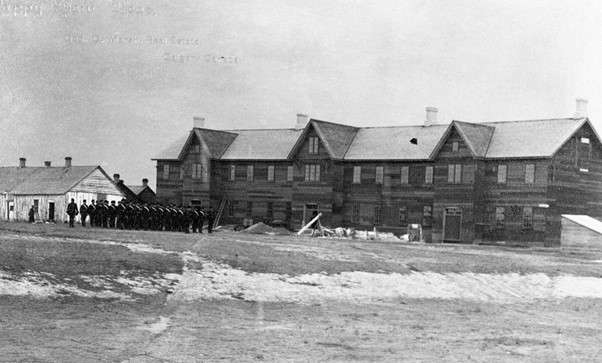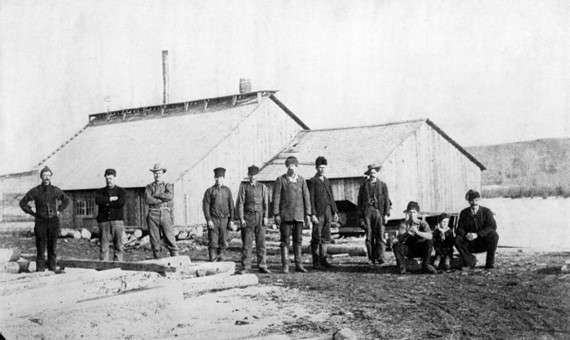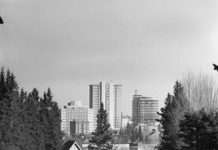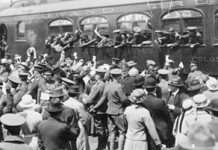
by Anthony Imbrogno, a volunteer with The Calgary Heritage Initiative Society/Heritage Inspires YYC
The NWMP arrived in 1874. Colonel Macleod met with Chief Crowfoot, who wanted respect for Blackfoot rights and encouraged friendly relations with the newcomers.
Conflict in America and the planned trans-continental railway led Canadian authorities to offer treaty negotiations with Indigenous peoples. The negotiations took place at Blackfoot Crossing, a traditional gathering place near Cluny, AB.
Crowfoot delivered an account of the talks to the other Chiefs. Land for settlement was exchanged for Indigenous land rights as well as farming support, food, and annuities. The Treaty was signed on September 22, 1877.
Increasing settlement and the buffalo’s near extinction upended the Treaty. As well, property was not part of Indigenous tradition, and the location and size of reserves was not clarified.
The end of the buffalo meant Indigenous peoples arrived on their reserves in need of food and shelter. The winter of 1883 to 1884 is known as the Starvation Winter. Government bureaucrats worsened the situation by restricting movements and limiting agricultural support.
Louis Riel returned from America to again argue for Indigenous rights. In 1885 at Batoche, SK, he established a provisional government. Shots were fired and the police retreated. Some Cree in Alberta took up the cause at Frog Lake, but Crowfoot would not side with Riel. Troops were ordered to Saskatchewan via the newly constructed railway. At the Battle of Batoche, the North-West Resistance ended, and Riel was tried and executed.
With the railway completed in 1885, Calgary was connected to the world. One result was more homesteading. American John Ware, a former slave, arrived and developed a reputation as a skilled and daring cowboy. Along Fish Creek, John Glenn’s irrigation system powered Samuel Shaw’s woollen mill.
Calgary was incorporated as a town in 1884. Surveyor William Pearce set aside St. George’s and St. Patrick’s Islands as parkland. James Walker, owner of Bow River Sawmill, expanded the fort. He was the first Board of Trade president and petitioned for a school district. In 1975 he was named Citizen of the Century.
With Cow Town firmly established, the next decade would shape the city you’re probably most familiar with today.
*All copyright images cannot be shared without prior permission.
https://digitalcollections.ucalgary.ca/asset-management/2R3BF1OY2G50?WS=SearchResults. “Blackfoot crossing, Bow River, Alberta.”, 1882, (CU181390) by Unknown. Courtesy of Glenbow Library and Archives Collection, Libraries and Cultural Resources Digital Collections, University of Calgary.
https://digitalcollections.ucalgary.ca/asset-management/2R3BF1FTUILG?WS=SearchResults. “Blood woman at the ration house, Blood reserve.”, 1897, (CU1156926) by Unknown. Courtesy of Glenbow Library and Archives Collection, Libraries and Cultural Resources Digital Collections, University of Calgary.
https://digitalcollections.ucalgary.ca/asset-management/2R3BF1O7TXV9?WS=SearchResults. “Start of the battle of Batoche, Saskatchewan.”, 1885, (CU198943) by Peters, James. Courtesy of Glenbow Library and Archives Collection, Libraries and Cultural Resources Digital Collections, University of Calgary.
https://digitalcollections.ucalgary.ca/asset-management/2R3BF1X2IA6W?WS=SearchResults. “Canadian Pacific Railway construction on the prairies.”, 1883, (CU1229514) by Unknown. Courtesy of Glenbow Library and Archives Collection, Libraries and Cultural Resources Digital Collections, University of Calgary.
https://digitalcollections.ucalgary.ca/asset-management/2R3BF1F2UGEB?WS=SearchResults. “S. W. Shaw’s original log house, Midnapore, Alberta.”, [ca. 1884-1885], (CU1123225) by Shaw, S. W. Courtesy of Glenbow Library and Archives Collection, Libraries and Cultural Resources Digital Collections, University of Calgary.
https://digitalcollections.ucalgary.ca/asset-management/2R3BF1OB69VI. “North-West Mounted Police barracks, Calgary, Alberta.”, 1888-12-20, (CU178952) by Ross, Alexander J. Courtesy of Glenbow Library and Archives Collection, Libraries and Cultural Resources Digital Collections, University of Calgary.
https://digitalcollections.ucalgary.ca/asset-management/2R3BF1OMO9J6?WS=SearchResults. “Colonel James Walker’s sawmill, Calgary, Alberta.”, [ca. 1880-1883], (CU182558) by Unknown. Courtesy of Glenbow Library and Archives Collection, Libraries and Cultural Resources Digital Collections, University of Calgary.















